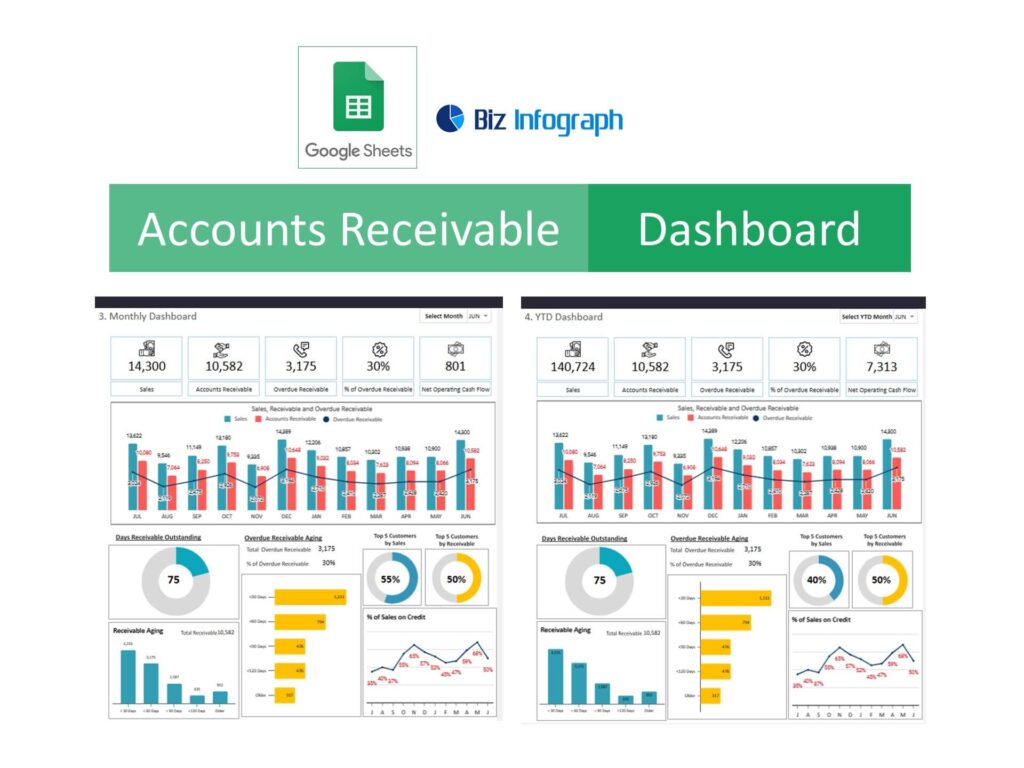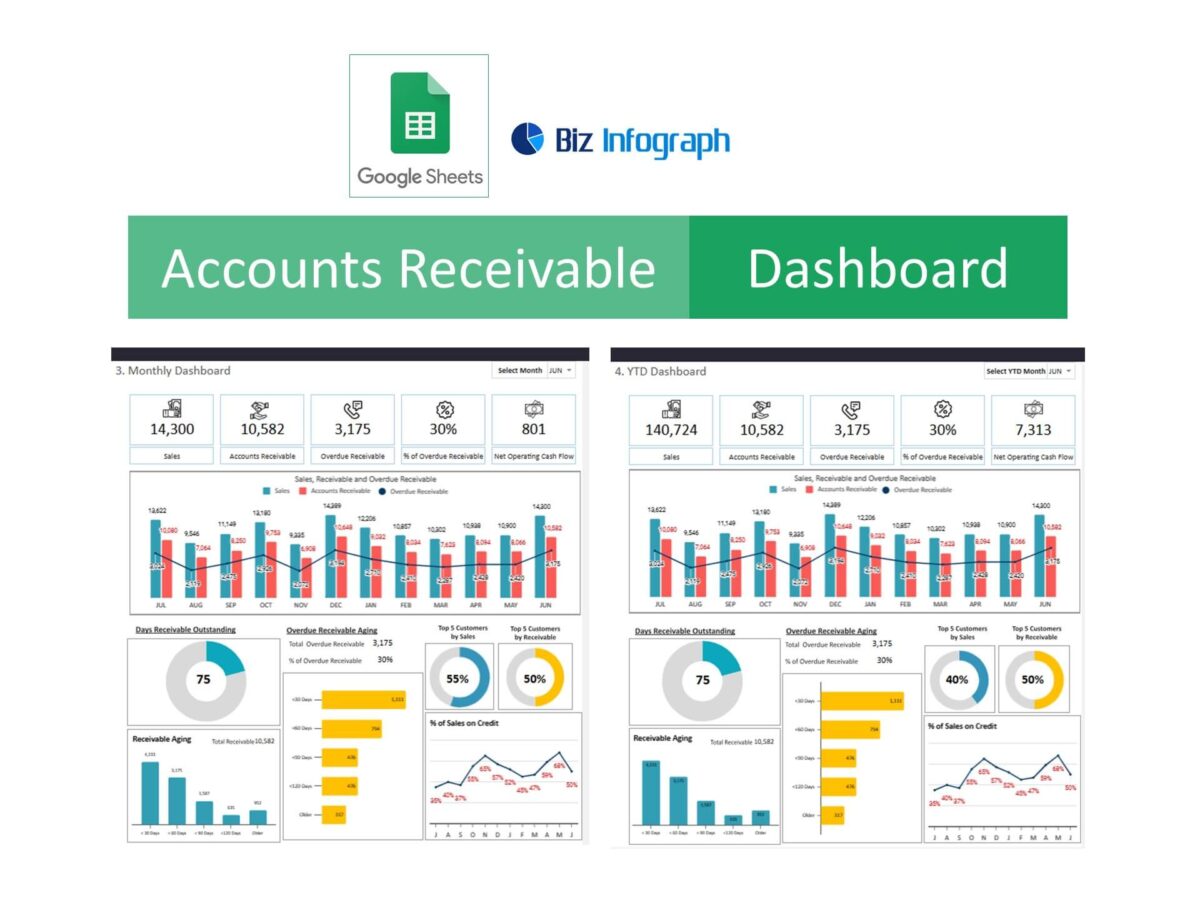Understanding Accounts Receivable

What is Accounts Receivable?
Accounts receivable (AR) refers to the outstanding invoices a company has or the money it is owed from clients. These are legally enforceable claims for payment held by a business for goods supplied or services rendered that customers have ordered but not yet paid for. Effective management of accounts receivable is crucial for maintaining healthy cash flow and ensuring the financial stability of a business. By using tools like a dashboard in Google Sheets, companies can streamline their accounting processes and get real-time visibility into who owes them money and how much, thus enhancing overall financial management.
Benefits of Tracking Accounts Receivables
Tracking accounts receivable meticulously offers numerous benefits. It helps businesses manage cash flow more effectively, ensuring they have enough liquidity to meet their obligations. By keeping an eye on outstanding invoices and receivables, companies can promptly identify customers who need a nudge to pay their bills. This proactive approach minimizes the risk of bad debt and enhances financial stability. Additionally, using tools like Google Sheets or Excel for tracking allows for real-time updates and better financial planning, helping businesses make informed decisions and maintain a balanced budget.
Creating an Accounts Receivable Dashboard in Google Sheets
Why Use Google Sheets?
Google Sheets offers numerous advantages for creating an accounts receivable dashboard. Its accessibility allows team members to collaborate in real-time, regardless of their location. This cloud-based platform is compatible with various data sources, facilitating easy integration with accounting software like QuickBooks. Moreover, Google Sheets supports automated updates and real-time data visualization, making it an ideal tool for monitoring who owes money and managing cash flow effectively. Its user-friendly interface and extensive functionality make it a preferred choice over traditional spreadsheet software like Excel.
Key Features of the Google Spreadsheet Template
A robust accounts receivable dashboard template in Google Sheets should include several key features. Automated invoice tracking is essential, allowing businesses to monitor who owes them money and when payments are due. The template should include an aging report to highlight outstanding invoices and overdue accounts. Customizable tabs can be added for different financial metrics, such as customer payments, cash flow, and budget tracking. Integration with live data sources, such as QuickBooks, enhances the template’s functionality, providing real-time updates and ensuring accurate financial reporting.
Step-by-Step Guide to Setting Up the Dashboard
Setting up an accounts receivable dashboard in Google Sheets involves several steps. First, gather all necessary accounts receivable data, including outstanding invoices and customer information. Create a new Google Sheets spreadsheet and set up tabs for different aspects of your AR management, such as invoices, payments, and aging reports. Use formulas and functions to automate calculations and data updates. Integrate the spreadsheet with your accounting software to ensure real-time data synchronization. Customize the dashboard to suit your specific needs, adding visual elements like charts and graphs to enhance data visibility and financial planning.
Template Description and Help
Detailed Template Description
The accounts receivable dashboard template in Google Sheets is designed to streamline AR management and enhance financial reporting. The template includes tabs for tracking invoices, payments, and aging reports, allowing businesses to monitor outstanding receivables effectively. Key features include automated calculations, real-time data updates, and customizable metrics. The template is compatible with both Google Sheets and Excel, making it versatile for different business needs. It also integrates with accounting software like QuickBooks, providing a comprehensive solution for managing AR processes and maintaining a healthy cash flow.
Template Help and Support
To get the most out of your accounts receivable dashboard template, utilize the available help and support resources. Many templates come with detailed guides and FAQs to assist with setup and customization. For more complex issues, consider reaching out to customer support or booking a demo with a real human expert. Online communities and forums can also provide valuable tips and troubleshooting advice. Regularly update the template based on user feedback to ensure it meets your business’s evolving needs and enhances overall financial management.
Use Cases for the Accounts Receivable Dashboard
Small Business Owners for Finance, Cash Flow, Agin Report
Small business owners can greatly benefit from using an accounts receivable dashboard template. It helps them monitor finance, client payments, track outstanding invoices, aging report, and manage cash flow more effectively. This is particularly useful for service businesses, such as those in the Airbnb rental market, where timely payments are crucial. The dashboard can also track subscription billing and rental income, providing a clear overview of the business’s financial health. By automating AR processes, small business owners can save time on bookkeeping and focus more on growing their business.
Service Businesses
Service businesses, which often rely on timely payments for sustainability, can leverage an accounts receivable dashboard to streamline their billing processes. By using Google Sheets or Excel templates, these businesses can track invoices, monitor payment status, and ensure that all client payments are received on time. The dashboard provides a clear overview of outstanding receivables and helps identify customers who need a nudge to pay their bills. This automation and visibility can significantly enhance cash flow management and reduce the risk of late payments or bad debt.
Related Templates
Accounts Payable Dashboard
An accounts payable dashboard complements the accounts receivable dashboard by tracking the company’s obligations to suppliers and vendors. This template can help businesses manage their payables, ensuring timely payments and maintaining good supplier relationships. It includes features like payment schedules, outstanding payables, and cash flow impact analysis. By integrating accounts receivable and accounts payable dashboards, businesses can get a comprehensive view of their financial health and improve overall the forecast of financial management.
Income and Expense Tracker
An income and expense tracker template is another valuable tool for businesses. It helps in monitoring all financial transactions, ensuring that income and expenses are accurately recorded. This template is particularly useful for budgeting and financial planning, as it provides a detailed overview of cash flow and financial performance. By integrating this tracker with the accounts receivable dashboard, businesses can maintain a balanced budget and make informed financial decisions. The template can be customized to track specific metrics relevant to the business’s operations.
Key Features to Track
Invoice Management
Effective invoice management is crucial for maintaining healthy cash flow. The accounts receivable dashboard template includes features for tracking issued invoices, due dates, and payment statuses. Automated reminders can be set up to nudge customers to pay their bills on time. By using this template in Google Sheets or Excel, businesses can streamline their invoice management processes, reduce the risk of overdue payments, and enhance overall financial stability. The template provides a clear overview of all outstanding invoices, helping businesses stay on top of their receivables.
Payment Monitoring
Monitoring payments is a key aspect of managing accounts receivable. The dashboard template helps businesses track received payments, reconcile them with issued invoices, and identify any discrepancies. Automated features in the template can highlight overdue payments and provide insights into payment trends. By keeping a close eye on payment statuses, businesses can ensure timely cash inflows, improve cash flow management, and maintain accurate financial records. The template’s real-time data updates and integration with accounting software further enhance its utility.
Financial Analytics
The accounts receivable dashboard template offers robust financial analytics features, allowing businesses to analyze their receivables data and gain valuable insights. By tracking key performance indicators (KPIs) such as days sales outstanding (DSO) and receivables turnover ratio, businesses can assess the efficiency of their AR processes. Visualizations like charts and graphs provide a clear representation of financial metrics, making it easier to identify trends and areas for improvement. This analytical capability helps businesses make data-driven decisions and optimize their financial strategies.
Automating Your Accounts Receivable Processes
Benefits of Automation
Automating accounts receivable processes offers significant benefits, including improved efficiency, reduced manual errors, and enhanced accuracy. Automation ensures that invoices are generated and sent promptly, payments are tracked in real-time, and reminders are automatically sent to customers with outstanding bills. By using tools like Google Sheets or Excel templates, businesses can streamline their AR processes and free up time for more strategic tasks. Automation also provides better visibility into receivables, helping businesses manage cash flow more effectively and make informed financial decisions.
Tools and Integrations
Several tools and integrations can enhance the functionality of your accounts receivable dashboard. Google Sheets and Excel templates can be integrated with accounting software like QuickBooks for real-time data synchronization. Add-ons and plugins, such as LiveFlow, can further automate data updates and financial reporting. These integrations ensure that your dashboard is always up-to-date and provide a comprehensive view of your financial status. By leveraging these tools, businesses can improve the accuracy of their AR management and streamline their accounting processes.
Using Excel or Google Sheets for AR Dashboards
Pros and Cons of Google Sheets
Google Sheets offers several advantages for creating and managing accounts receivable dashboards. Its cloud-based nature allows for real-time collaboration and accessibility from any location. Google Sheets also integrates seamlessly with other Google services and third-party applications, enhancing its functionality. However, it may have limitations in handling very large datasets compared to Excel. Additionally, some advanced features available in Excel might not be present in Google Sheets. Despite these limitations, Google Sheets remains a popular choice for its ease of use and collaborative capabilities.
Pros and Cons of Excel
Excel is renowned for its advanced features and robust functionality, making it a powerful tool for creating accounts receivable dashboards. It can handle large datasets efficiently and offers a wide range of functions and formulas for complex financial analysis. Excel’s customization options and compatibility with various data sources make it highly versatile. However, it lacks the real-time collaboration features of Google Sheets and requires a software license, which can be a drawback for some users. Nonetheless, Excel is preferred for its comprehensive capabilities and detailed analytics.
Template Customization and Compatibility
Customizing for Specific Needs
Customizing your accounts receivable dashboard template to meet specific business needs is crucial for effective AR management. You can tailor the template by adding or removing data fields, adjusting visual elements, and setting up specific metrics to track. Whether using Google Sheets or Excel, ensure that the template aligns with your business processes and financial goals. Customization allows you to focus on the most relevant data, streamline your AR management, and improve overall financial reporting. Regularly update the template based on user feedback and evolving business needs.
Compatibility with Other Templates
Ensuring compatibility between your accounts receivable dashboard and other financial templates enhances overall financial management. For instance, integrating the AR dashboard with an accounts payable dashboard provides a comprehensive view of both receivables and payables, facilitating better cash flow management. Similarly, linking it with an income and expense tracker or a budget spreadsheet can offer detailed insights into financial performance. Compatibility with various templates and tools, such as QuickBooks or LiveFlow, ensures seamless data synchronization and enhances the utility of your financial management system.
Recommended Tools and Software
To enhance your accounts receivable management, consider using a variety of tools and software. Google Sheets and Excel templates provide robust solutions for tracking AR processes. Accounting software like QuickBooks offers seamless integration with these templates, ensuring real-time data updates. Add-ons such as LiveFlow can further automate data entry and financial reporting. By leveraging these tools, businesses can streamline their AR management, improve accuracy, and make informed financial decisions. Regularly exploring new tools and software can help you stay updated with the latest advancements in financial management.
You may be interested:
